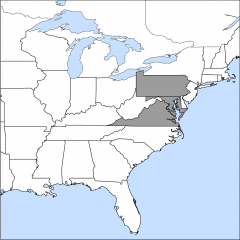Rich Boulderfield Forest (Central Appalachian-Piedmont)
Learn More
Where to Explore It
American basswood and American bladdernut are common in the Rich Boulderfield Forest, which occurs on slopes partially covered with boulders. (There is more than one type of Rich Boulderfield Forest; this one is found in the Central Appalachian mountains and in the Piedmont.)
This natural community is found on slopes in the Central Appalachian mountains, usually facing a river or stream. Boulders are a prominent feature of the surface, but typically cover less than half.
The range map shows the states in which this natural community has been documented.
More About This Natural Community
The Rich Boulderfield Forest occurs on slopes partially covered with boulders. The boulders come from bedrock high in calcium-rich minerals that promote plant growth. As the boulders erode, they contribute to soil fertility. Nutrient-loving plants grow here, but they may be somewhat widely spaced because of all the boulders.
Trees in this community include American basswood, white ash, and sugar maple. In the shrub layer, American bladdernut is common. In the spring and summer look for the blooms of cutleaf toothwort, squirrel-corn, and pale jewelweed.
For a more in-depth look at this community, click on a link under “Where to Explore It.”
Look for It in These National Parks
- Appalachian Trail (Central Appalachians)
- Chesapeake and Ohio Canal National Historical Park
- George Washington & Jefferson National Forests
- George Washington Memorial Parkway
- Harpers Ferry National Historical Park
Conservation Status
How vulnerable is a natural community? Is it at risk of elimination? Learn about conservation status.
Classification
Official names reduce confusion by providing a common language for talking about natural communities. Why so many names?



